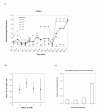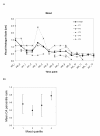Applying a brain-computer interface to support motor imagery practice in people with stroke for upper limb recovery: a feasibility study
- PMID: 21156054
- PMCID: PMC3017056
- DOI: 10.1186/1743-0003-7-60
Applying a brain-computer interface to support motor imagery practice in people with stroke for upper limb recovery: a feasibility study
Abstract
Background: There is now sufficient evidence that using a rehabilitation protocol involving motor imagery (MI) practice in conjunction with physical practice (PP) of goal-directed rehabilitation tasks leads to enhanced functional recovery of paralyzed limbs among stroke sufferers. It is however difficult to confirm patient engagement during an MI in the absence of any on-line measure. Fortunately an EEG-based brain-computer interface (BCI) can provide an on-line measure of MI activity as a neurofeedback for the BCI user to help him/her focus better on the MI task. However initial performance of novice BCI users may be quite moderate and may cause frustration. This paper reports a pilot study in which a BCI system is used to provide a computer game-based neurofeedback to stroke participants during the MI part of a protocol.
Methods: The participants included five chronic hemiplegic stroke sufferers. Participants received up to twelve 30-minute MI practice sessions (in conjunction with PP sessions of the same duration) on 2 days a week for 6 weeks. The BCI neurofeedback performance was evaluated based on the MI task classification accuracy (CA) rate. A set of outcome measures including action research arm test (ARAT) and grip strength (GS), was made use of in assessing the upper limb functional recovery. In addition, since stroke sufferers often experience physical tiredness, which may influence the protocol effectiveness, their fatigue and mood levels were assessed regularly.
Results: Positive improvement in at least one of the outcome measures was observed in all the participants, while improvements approached a minimal clinically important difference (MCID) for the ARAT. The on-line CA of MI induced sensorimotor rhythm (SMR) modulation patterns in the form of lateralized event-related desynchronization (ERD) and event-related synchronization (ERS) effects, for novice participants was in a moderate range of 60-75% within the limited 12 training sessions. The ERD/ERS change from the first to the last session was statistically significant for only two participants.
Conclusions: Overall the crucial observation is that the moderate BCI classification performance did not impede the positive rehabilitation trends as quantified with the rehabilitation outcome measures adopted in this study. Therefore it can be concluded that the BCI supported MI is a feasible intervention as part of a post-stroke rehabilitation protocol combining both PP and MI practice of rehabilitation tasks. Although these findings are promising, the scope of the final conclusions is limited by the small sample size and the lack of a control group.
Figures







Similar articles
-
The Promotoer, a brain-computer interface-assisted intervention to promote upper limb functional motor recovery after stroke: a study protocol for a randomized controlled trial to test early and long-term efficacy and to identify determinants of response.BMC Neurol. 2020 Jun 27;20(1):254. doi: 10.1186/s12883-020-01826-w. BMC Neurol. 2020. PMID: 32593293 Free PMC article.
-
Efficacy of brain-computer interface training with motor imagery-contingent feedback in improving upper limb function and neuroplasticity among persons with chronic stroke: a double-blinded, parallel-group, randomized controlled trial.J Neuroeng Rehabil. 2025 Jan 6;22(1):1. doi: 10.1186/s12984-024-01535-2. J Neuroeng Rehabil. 2025. PMID: 39757218 Free PMC article. Clinical Trial.
-
Brain computer interface training with motor imagery and functional electrical stimulation for patients with severe upper limb paresis after stroke: a randomized controlled pilot trial.J Neuroeng Rehabil. 2024 Jan 20;21(1):10. doi: 10.1186/s12984-024-01304-1. J Neuroeng Rehabil. 2024. PMID: 38245782 Free PMC article. Clinical Trial.
-
Is motor-imagery brain-computer interface feasible in stroke rehabilitation?PM R. 2014 Aug;6(8):723-8. doi: 10.1016/j.pmrj.2014.01.006. Epub 2014 Jan 12. PM R. 2014. PMID: 24429072 Review.
-
Neurofeedback and Brain-Computer Interface-Based Methods for Post-stroke Rehabilitation.Appl Psychophysiol Biofeedback. 2025 May 28. doi: 10.1007/s10484-025-09715-z. Online ahead of print. Appl Psychophysiol Biofeedback. 2025. PMID: 40434551 Review.
Cited by
-
Paving the Way for Motor Imagery-Based Tele-Rehabilitation through a Fully Wearable BCI System.Sensors (Basel). 2023 Jun 23;23(13):5836. doi: 10.3390/s23135836. Sensors (Basel). 2023. PMID: 37447686 Free PMC article.
-
Feasibility of a hybrid brain-computer interface for advanced functional electrical therapy.ScientificWorldJournal. 2014 Jan 27;2014:797128. doi: 10.1155/2014/797128. eCollection 2014. ScientificWorldJournal. 2014. PMID: 24616644 Free PMC article.
-
Brain-Machine Interfaces: Powerful Tools for Clinical Treatment and Neuroscientific Investigations.Neuroscientist. 2019 Apr;25(2):139-154. doi: 10.1177/1073858418775355. Epub 2018 May 17. Neuroscientist. 2019. PMID: 29772957 Free PMC article. Review.
-
Therapeutic Applications of BCI Technologies.Brain Comput Interfaces (Abingdon). 2017;47(1-2):37-52. doi: 10.1080/2326263X.2017.1307625. Epub 2017 Apr 10. Brain Comput Interfaces (Abingdon). 2017. PMID: 29527538 Free PMC article.
-
Four methods of brain pattern analyses of fMRI signals associated with wrist extension versus wrist flexion studied for potential use in future motor learning BCI.PLoS One. 2021 Aug 17;16(8):e0254338. doi: 10.1371/journal.pone.0254338. eCollection 2021. PLoS One. 2021. PMID: 34403422 Free PMC article. Clinical Trial.
References
-
- World Health Organization: Global Report. 2002. http://www.who.int/whr/2002/en/index.html [Last accessed on 13 January 2007]
Publication types
MeSH terms
LinkOut - more resources
Full Text Sources
Medical
Miscellaneous

